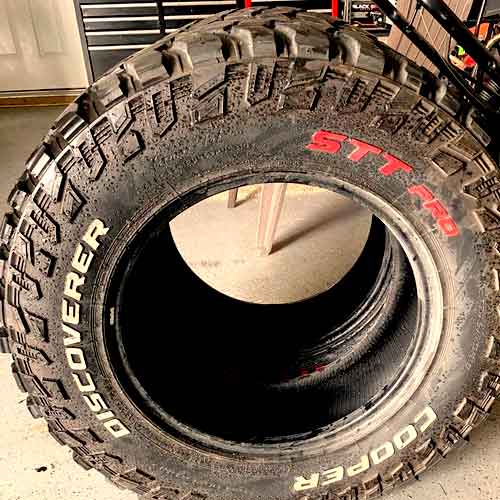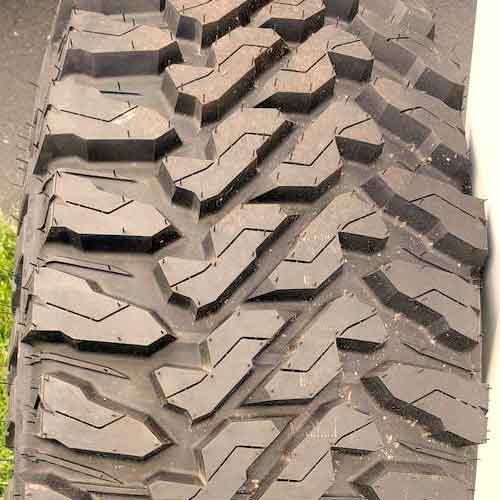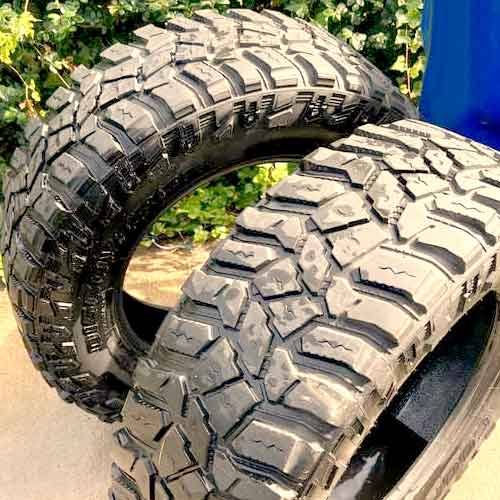Cooper Discoverer STT Pro and the Yokohama Geolandar MT are although both aggressive mud-terrain tires, they are built very differently, and so they get to provide very different performance results on various types of terrains, lets check them out!

As a tire engineer, I believe that the Cooper Discoverer STT Pro is one of the best M/T tires for tackling rocky terrain, thanks to its arbitrary placement of ribs all over the tread. The Yokohama Geolandar MT, on the other hand, offers a smoother ride on pavement, providing better steering communication and traction in all weather conditions. However, it does not compromise on performance in muddy terrains.
Table of Contents
Tread Design
The Yokohama M/T offers a standard mud-terrain design with 2 central ribs and prominent shoulder lugs, towards edges.

In the middle, the tire features 2 unique lugs, with sharp off-sets, and chamfered edges.
And although it’s tread has a softer compound, these blocks have reinforced foundations underneath, so they stay firm during braking and handling, improving dry grip.
As for wet, they carry full depth siping on them, and these sipes are greater in number compared to Cooper STT Pro, as you’ll see..
Moving towards shoulders. The lugs here carry much more surrounding space, even more than the wide circumferential grooves they make.
So its tread offers great self cleaning, and aiding to that, are bold stone ejectors as well.
These shoulder lugs are staggered on the outer edges, and make thick slanted pattern on sidewalls, though they don’t cover as much space there as its competitor.
Moving towards other tire, the Cooper Discoverer STT Pro really stands out with its’ swooping lugs.

These lugs actually creates wider lateral channels (and narrower circumferential grooves), so it’s sideways evacuation of mud/dirt and water is superior in comparison.
Basically, the tire’s whole structure is simply made by 3 ribs, with a single central column having 3 different lugs.
These blocks have small but full depth interlocking sipes, off-set edges, and foundational supports.
The outer ribs have shoulders running in pairs.
One is slightly thicker and has M shaped siping pattern on it, while the consecutive one is elongated and is featured with notches and more aggressive edges.
Together they make staggered sides, and sharp knives on the sidewalls creating tremendous off road bite, especially when you lower the air pressure.
Detailed Review of Cooper STT Pro: https://tiredriver.com/cooper-discoverer-stt-pro-review/
Durability
Mud-terrain tires need to be powerful, so they be puncture proof on rugged terrains. And to make these tires strong, they are equipped with plies in their internal construction.
Though more plies also increases the weight of the tire, and that affects other performance areas like the fuel economy and handling, so to handle this, both tire companies only offer a single nylon cap ply.
And to keep things strong as well, these cap plies have 2 wide steel belts underneath them, which sit on 3 ply polyester carcass.
But still, with deeper tread, and thicker sidewall lugs, the Cooper STT Pro still gets to have an upper hand.
Sizes Facts
The Cooper Discoverer STT Pro:
- Has total sizes: 49 (15 to 22 inches wheel diameters).
- All have speed rating of Q.
- Load Ratings vary in C to F.
- Weight Range: 42 lbs to 94 lbs.
- Tread Depth Range: 18 to 22/32″.
On the other side, Yokohama Geolandar M/T G003:
- Comes in 37 sizes in 15 to 24 inches.
- They all also have speed ratings of Q.
- And have same load ratings: C to F.
- Tread Depth Range: 17 to 21/32″.
- Weight Range: 30 to 80 lbs (Lighter in comparison).
Wet Traction
Since water is not compressible, the only way for tires to achieve wet traction is through effective water removal. This involves considering both hydroplaning resistance and grip.
Wet Traction:
Water is not compressible, so it need to get out as soon as possible, that’s they only way to grip.
Most of the water underneath the tire gets out by the help of grooves, while the rest have to cleaned off by sipes.
So out of both tires with more number of interlocking sipes available on Geolandar M/T and are also quite flexible too int he first place, the tire gets to have better traction values here in comparison.
Though the Cooper Discoverer does better in another component of wet traction, discussed below.
Aquaplaning
Aquaplaning, also referred to as hydroplaning, occurs when a tire is unable to clear water from its tread at a fast enough rate, causing the tire to float and resulting in a loss of traction.
But with such voided tires like these two, it’s not much of an issue, as water simply moves out in a much easier way.
Though still, one thing to consider here is that, there are two parts of hydroplaning resistance, and these include, curved aquaplaning and straight aquaplaning (these tell how well tire evacuates water sideways and longitudinally).
And since the Cooper STT Pro provides you with a better network of grooves, it does slightly better here, though its still not enough to allow it to outperform Yokohama Geolandar M/T.
Dry Performance
To get a comprehensive understanding of tire’s dry performance, it is important to consider “dry” grip, handling, and Steering feeback ability. Let’s look at each of these factors individually.
Grip
Directional grip, which refers to a tire’s braking and acceleration performance, is largely determined by the tire’s footprint. The larger the footprint, the better the directional grip.
And here with longitudinally aligned lugs of Yokohama M/T are able to create much better output yielding shorter braking distances.
On the other hand, the Cooper does better in the section below.
Handling
Tire handling refers to the tire’s performance when turning, and is influenced by the tire’s shoulders, which bear the majority of the vehicle’s weight during turns.
So it makes sense why Cooper STT Pro is able to offer faster lap times (calculated on average), where it’s elongated lugs produce greater lateral g forces.
Steering Feedback
Tire responsiveness, a measure of how well a tire responds to steering inputs, is influenced by tread’s continuity.
And so with Yokohama Geolandar M/T making better consistency with the road, in both directional and lateral moving paths, it’s provides a faster feedback to your steering inputs.
Moreover, the tires lighter weight and narrower section width is also helping it a lot. With these, it tends to create a greater balance between under and over steering.
Fuel and Tread Usage
Both fuel and tread have a lot of contributing factors, including weight, compound and rolling resistance.
And having said that, out of both tires, the Cooper Discoverer STT Pro with it’s heavier weight combined with more number of biters, get to produce larger rolling resistance values. So it consumes more fuel comparatively.
Though with, larger tread depth, and its harder rubber, with is less susceptible to get worn off quickly, the tire still provides you with better life, despite having more rolling resistance compared to Yokohama M/T.
Ride Quality
Both tires being extreme off-road performers, aren’t so oriented to yield a comfortable enough ride, but sure their softer rubber do provide some king of bumps absorption on both off and on roads.
Nonetheless, with a softer composition, are a tread depth reaching up to 21/32″, the Yokohama M/T still offers slightly better results overall.
And same goes for its noise levels on roads too.
Although both tires are going to be loud, the Geolandar M/T has the advantage of providing better pitch sequencing, (some also call it variable pitch technology).
This basically allows air hitting the tread to create self cancelling sound waves, and this way noise is dampened considerably.
Winter Traction
Both ties are although not 3 peak mountain snowflake rated, they are still good enough with deeper snowy terrains going above 3 feet without any hurdles.
It’s basically a misconception that tires with only 3pmsf rating can perform well on snow. And braking that myth in mud-terrain tires especially (where you don’t find any tire with that symbol), is Yokohama Geolandar M/T.
The whole Geolandar series in fact, is pretty great on snow, and out of those 3 tires, (you can find them in the search bar below), AT G015, X-AT G016, and M/T G003 over here, only the A/T gets to have the 3 Peak symbols. The rest only have M+S.
So what makes the M/T version better?
Well, first things first, it’s lugs are aligned in a way to pickup the snow in it’s groove quickly, and aiding that is its narrower section width, that basically puts more pressure on the snow (larger weight on a smaller surface area).
With this the tire is able to create a snow to snow contact which is ideal on this terrain.
Moreover, due to the tire’s softer composition, and thermal adaptable nature, its not very susceptible to get frozen up quickly (a feature best seen on winter tires, that’s why they are so soft).
The Cooper Discoverer STT Pro on the other side, is not able to create as impressive of a snow to snow exposure, nor it’s stiffer compound is able to resist too much of the cold. So it lacking overall in comparison here.
Off Road Traction
Off-road tires should be able to withstand a wide variety of terrains, though some are more important to be considered. I’ve mentioned them all below and explained how much these tires are capable on each.
On Mud
Mud-terrain tires are named that why because mud is the toughest of all terrains, and on this terrain you need faster evacuation capabilities.
And here considering both tires, you can’t really put one over the other, as the Cooper STT Pro provides better lateral escape for mud, and the Yokohama is good at moving mud out longitudinally.
So, I’ve rated both tires equal here.
On Rocks
For rocks, in the M/T category, my go to tire is Cooper STT Pro, as this tire provides a well balanced combination of lateral and circumferential traction, where like other tires, it does not limit one for the sake of (improving) the other.
Moreover, it’s sidewall biters are also much more efficient in comparison.
The Yokohama Geolandar M/T on the other side, although offers good enough traction, it’s lacking in lateral traction component here.
Sand Traction
Sand is not an easy terrain for both drivers and the tires, and here you need a tire which is lighter in weight, and can offer better footprint.
These features basically tell how much the tire “digs”, which is almost the main focus with tire’s traction on sand.
That’s because on sand, digging is your worse enemy. And out of both tires, its seen less on Cooper Discoverer STT Pro even though the tire weighs more comparatively.
Basically this tire here has larger section width (on average), and so with that combined with thicker sidewall lugs, the whole weight of the tire is distributed on a larger surface area.
Yokohama M/T on the other side, with its narrower tread, and sharper sides is not able to produce much better results even though the tire gets to be lighter in weight.
For your info: Out of all the mud terrain tires, I’ve rated BF Goodrich KM3 best for sandy terrain.
Take Home Points
On Cooper STT Pro, you are going to see better rocky and sandy terrain traction off-road, and on pavements, a better grip, but only on dry.
The Yokohama M/T on the other hand, provides better all season traction, so it’s not only better in wet, but also in snow.
And off road, although it lacks on rocks and sandy dunes, it’s mud traciton is on par with its competitor.